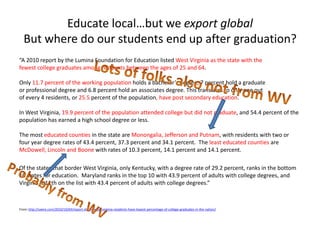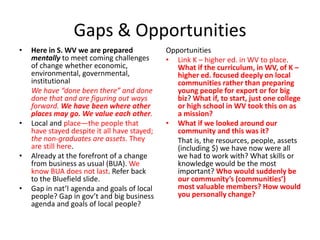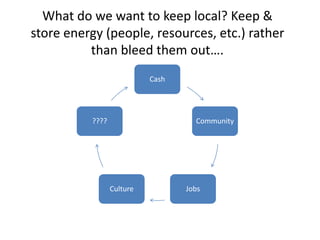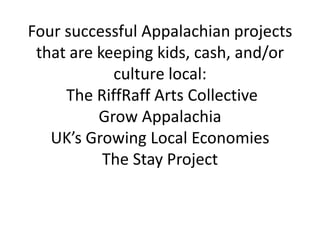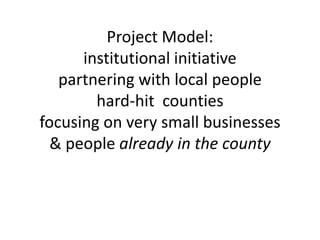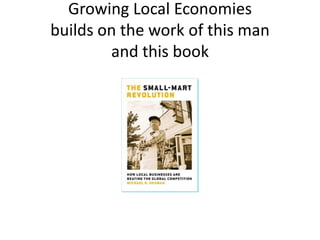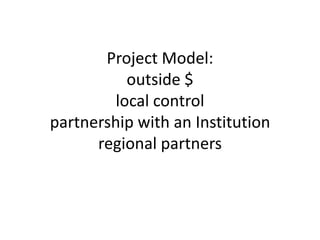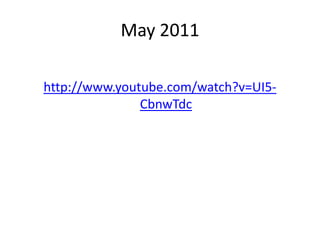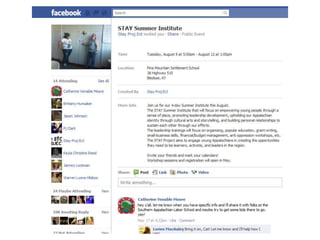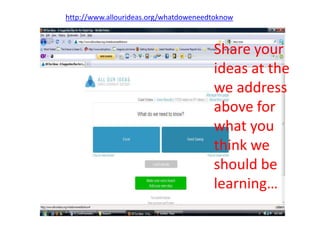How to Keep Kids, Cash & Culture local
- 1. Keeping it LocalHow to keep kids, cash, and culture in the communityin three parts:Where and what we areWhat people are doing about itWhat we can do nextCrystal Allene [email protected] 2011This work is licensed under the Creative Commons Attribution-NonCommercial 3.0 Unported License. To view a copy of this license, visit http://creativecommons.org/licenses/by-nc/3.0/ or send a letter to Creative Commons, 444 Castro Street, Suite 900, Mountain View, California, 94041, USA.
- 2. Where and what we are in Central Appalachia (Southern West Virginia). Also relevantto other areas in economic decline.
- 3. Urban AppalachiaEmpty street, empty parking building, the City of Bluefield, WV, 2010Photo by Terry RoweWe know things changeBusiness asUsual does not last…
- 4. Urban AppalachiaBluefield, WV, 2010Photo by Terry RoweBusinesses do not lastforever…
- 5. Urban AppalachiaHotel Matz/Hotel Milner collapses on its own, Downtown, Bluefield, WV, 2009Photo by Terry RoweEven beautiful things some day fall apart, even on their own…
- 6. Educate local…but we export globalBut where do our students end up after graduation?“A 2010 report by the Lumina Foundation for Education listed West Virginia as the state with thefewest college graduates among residents between the ages of 25 and 64.Only 11.7 percent of the working population holds a bachelor’s degree, 7 percent hold a graduateor professional degree and 6.8 percent hold an associates degree. This translates to only one outof every 4 residents, or 25.5 percent of the population, have post secondary education.In West Virginia, 19.9 percent of the population attended college but did not graduate, and 54.4 percent of thepopulation has earned a high school degree or less.The most educated counties in the state are Monongalia, Jefferson and Putnam, with residents with two orfour year degree rates of 43.4 percent, 37.3 percent and 34.1 percent. The least educated counties areMcDowell, Lincoln and Boone with rates of 10.3 percent, 14.1 percent and 14.1 percent.Of the states that border West Virginia, only Kentucky, with a degree rate of 29.2 percent, ranks in the bottom10 states for education. Maryland ranks in the top 10 with 43.9 percent of adults with college degrees, andVirginia is 11th on the list with 43.4 percent of adults with college degrees.”From: http://uwire.com/2010/10/04/report-shows-west-virginia-residents-have-lowest-percentage-of-college-graduates-in-the-nation/Lots of folks also not from WVProbably from WV
- 7. Expected job growth in mining is flat over the next 10 yrsUS Labor Stats, http://www.bls.gov/emp/home.htm#indtables
- 8. Nat’l focus of ed & businessBiz biz/not localThe Partnership for 21st Century Skills• Adobe Systems, Inc. • American Association of School Librarians • Apple • ASCD • Blackboard, Inc. • Cable in the Classroom• Crayola • Cisco Systems, Inc. • Corporation for Public Broadcasting • Dell, Inc. • EF Education • Education Networks of America • Educational Testing Service • Gale, Cengage Learning • Hewlett Packard • Houghton Mifflin Harcourt • Intel Corporation • JA Worldwide® • K12 • KnowledgeWorks Foundation • LEGO Group • Lenovo • Learning Point Associates • Leadership and Learning Center • McGraw-Hill • Measured Progress • Microsoft Corporation • National Education Association • National Academy Foundation • Nellie Mae Education Foundation • netTrekker • Oracle Education Foundation • Pearson • Project Management Institute Educational Foundation • Quarasan! • Scholastic Education • Sesame Workshop • Sun Microsystems, Inc. • The Walt Disney Company • Verizon from: (http://www.p21.org)
- 9. Gaps & OpportunitiesHere in S. WV we are prepared mentallyto meet coming challenges of change whether economic, environmental, governmental, institutionalWe have “done been there” and done done that and are figuring out ways forward. We have been where other places may go. We value each other.Local and place—the people that have stayed despite it all have stayed; the non-graduates are assets. They are still here.Already at the forefront of a change from business as usual (BUA). We know BUA does not last. Refer back to the Bluefield slide.Gap in nat’l agenda and goals of local people? Gap in gov’t and big business agenda and goals of local people?OpportunitiesLink K – higher ed. in WV to place. What if the curriculum, in WV, of K – higher ed. focused deeply on local communities rather than preparing young people for export or for big biz? What if, to start, just one college or high school in WV took this on as a mission?What if we looked around our community and this was it? That is, the resources, people, assets (including $) we have now were all we had to work with? What skills or knowledge would be the most important? Who would suddenly be our community’s (communities’) most valuable members? How would you personally change?
- 10. One guiding principle of engineering:Design a system, a product, etc. to withstand more weight than it can bear. Design a system, a product, etc. to withstand extremes to which it may never be subjected.
- 11. How much more extreme does it have to get?Here in Southern WV, we have already been subjected to the extremes: our towns have left us, our people have left, our environment has some serious issues, the education pushed by a national agenda and a state-level agenda does not match up with the reality or even maybe what a lot of people that have stayed want….
- 12. What do we want to keep local? Keep & store energy (people, resources, etc.) rather than bleed them out….
- 13. The list below is from: http://www.livingeconomies.org/node/513#comment-4820 Measures for a Successful Local Living EconomyBy Michael H. Shuman, Research & Economic Development Director, BALLEThis list elaborates what broadly could be measured to determine whether a community is progressing toward Local Living Economy goals. Admittedly,some of these indicators would be harder to construct than others, but none are beyond the measuring capabilities of most local governments.Local Ownership – What percentage of jobs in the local economy are in locally owned businesses?Self-Reliance – To what extent is the community self-reliant, especially in the basics of food, shelter, energy, and water?Socially Responsible Business — To what extent are businesses present across all sectors of the local economy that are achieving high levels of triple-bottom-line success?Youth – What’s the probability that young people stay in your community once they have graduated from high school (or return to the community after college)? A related question: What’s the likelihood that a young person can have fun in your community without breaking the law?Schools – What’s the probability that members of every age group in your community are increasing the amount of time they spend learning this year, compared to last year.Entrepreneurship – What’s the likelihood that an entrepreneur in your community, especially a young person, can find the capital, technical assistance, mentorship, and other support that makes it possible for him or her form a small business that he/she is passionate about?Relationships – What’s the likelihood that every resident knows the names of everyone on his or her block, and that the block throws block parties?Arts – To what extent are artists, writers, musicians, and other cultural creative drawn to live in your community?Safety Net – What’s the probability that the poorest members of the community find adequate food, shelter, and health care.Diversity – To what extent does your community have a rich diversity of races, ethnicities, ages, religions, and political viewpoints?Aging – To what extent has the concept of retirement been abolished and replaced by seniors embracing new personal and community missions as they age?Volunteerism – What’s the probability that a resident has run for office, worked for a government program, or volunteered for a community initiative or an act of civic governance?Sustainability – What’s the degree to which your community meets its needs, present and future, without impairing the ability of other communities to meet their needs, present and future?Investment – What’s the percentage of your residents’ retirement savings that’s invested in local business?Tourism – The degree to which outsiders come to visit in part because they regard you as a model community?Walkability – What percentage of your residents can find most of what they need – for work, school, purchasing, and play – within a 10 minute walk from home? What percent of people living in your community work there?Subsidies – To what extent is every penny of city money linked to business development is invested exclusively in locally owned business?10% Shift – What percent of your community’s purchasing decisions – including those of consumers, businesses, and procurement agencies – are going to local goods and services?Celebrations – To what extent are your conferences (like this one) places where solutions to once hopeless problems are shared and celebrated?Global Self-reliance – To what extent are you sharing your best practices in achieving all of the above with other communities globally? How much time and money are you spending to help other communities worldwide to achieve the level of self-reliance you seek for yourself?Cash -> -> Kids -> -> Kids & cash -> -> Kids & cash & culture-> Cash -> ->
- 14. What people are doing about it
- 15. Four successful Appalachian projects that are keeping kids, cash, and/or culture local: The RiffRaff Arts Collective Grow AppalachiaUK’s Growing Local EconomiesThe Stay Project
- 16. Project Model:institutional initiativepartnering with local peoplehard-hit countiesfocusing on very small businesses& people already in the county
- 17. Growing Local Economies at UKWhen people think of economic development, they usually think about creating jobs by attracting businesses to a region. Of course, job creation is important, but it is only part of the story. The Growing Local Economies initiative represents an alternative approach. It looks at the economy as a whole--where money and resources flow in and out of a community--and works to create conditions that build local prosperity.Growing Local Economies searches for ways to structure the local or regional economy to benefit the most people now, while reducing negative impacts on the quality of life of future generations. It concentrates on increasing the proportion of goods and services purchased locally by both consumers and by businesses. When a community buys goods and services from outside businesses rather than local businesses, money "leaks" out of the community. On the other hand, when a community uses more locally-produced goods and services, more money circulates inside the community. This extra money can be used to build prosperity.Local ownership is part of the story. Locally-owned businesses can make business decisions that benefit the community, and they are usually better at circulating money than businesses controlled by outside interests. Local businesses also spend more money locally.
- 18. Growing Local Economieshttp://www.appalachiancenter.org/GrowingLocalEconomiesGrowing Local Economies builds on the existing resources within communities to improve their economic situations. Specific resources include current businesses, local people and their knowledge and skills, and supports for economic development like education, training, infrastructure, and policies.This project specifically focuses on the power of locally owned, import-replacing businesses, a philosophy called LOIS. Local ownership matters because: • Local businesses spend more money locally. • Businesses anchored locally produce wealth for many years, often many generations. • Communities can raise labor and environmental standards with confidence that its businesses will adapt rather than leave the community.• It promotes smart growth and walkable communities, draws in tourists through unique stores and attractions, and retains talented young people who could open businesses of their own. • Local business economies tend to have more social stability, lower levels of welfare, and greater political participation.
- 19. Growing Local Economiesbuilds on the work of this man and this book
- 20. Growing Local EconomiesTakeaways….Small businesses don’t leave—they stay when people support them– not affected by larger shareholder decisions$$$ from small businesses stays in the community. Small business can be micro-businesses and take much less capital to startSmall businesses need fewer resources: energy, space, etc.Self-Reliance – To what extent is the community self-reliant, especially in the basics of food, shelter, energy, and water? Small business increases community know-how and keeps skills in the community.Saves the community cash…over the long run (keeps $ circulating in the community)Reconnects people to one anotherEntrepreneurship – What’s the likelihood that an entrepreneur in your community, especially a young person, can find the capital, technical assistance, mentorship, and other support that makes it possible for him or her form a small business that he/she is passionate about?10% Shift – What percent of your community’s purchasing decisions – including those of consumers, businesses, and procurement agencies – are going to local goods and services?
- 21. Project Model:outside $local controlpartnership with an Institutionregional partners
- 22. Grow AppalachiaTo teach and support the people of Appalachia in addressing the tragedy of hunger in the region by learning to grow their own food to feed themselves.From: http://www.paulmitchell.com/OurStory/CultureOfGiving/Pages/Home.aspx
- 25. Primary Benefits to the People of Central AppalachiaThe primary benefits to the people of Central Appalachia will be:Healthy local food options.Increased self-esteem through agency and autonomy.Enhanced sense of community, resiliency, and partnership through rediscovery of Appalachian heritage and knowledge.More personal income retained resulting from not having to pay high costs of imported food.Potential source of income from local farmers’ markets and cooperative regional marketing.Spreading of the knowledge and seeds of various ancient, heirloom varieties of different vegetables which were a critical part of the mountaineers’ heritage but are now in danger of being lost.From: http://www.berea.edu/appalachiancenter/growappalachia/primarybenefits.asp
- 26. Needs, Goals and OutcomesSome of the most pressing regional needs to be addressed by Grow Appalachia are:Basic diet-related health concerns – obesity, diabetes, heart disease.Limited availability of high-quality fresh produce.Generational loss of knowledge of gardening, cooking, and food preservation skills.Widespread economic dependency and lack of autonomy. Some of the planned outcomes will be:Provide mountain families the resources and support to produce more of their own food.Develop systems to share surplus produce with elderly and disabled folks at little or no cost.Create systems to market surplus produce to local residents or, cooperatively, to a wider regional market. Families benefiting from this program will agree to help other families as they are able to maximize the impact of the program
- 27. David Cooke ’82 is a southern West Virginia native whose maternal and paternal Appalachian roots go back over a century. He has a B.A. from Berea College & an MS from WVU. Served as a WVU county extension agent in the southern WV coal fields region. While primarily working with WV landholders and entrepreneurs in agroforestry and other natural resource-based small business enterprises, Cooke also has extensive experience in volunteer management, outreach education systems and grant writing. Cooke joins Berea College as EPG’s Program Coordinator and Director of the Appalachian Fund.Cooke (paraphrased): We thought about creating a farmer’s market from what was produced through Grow Appalachia, but people kept giving away their food! That is part of our Appalachian culture… When they can, to make sure everyone has enough to eat.http://www.berea.edu/epg/people/davidcooke.asp
- 28. Grow Appalachia Takeaways….People come together around food in our cultureFood is central in our lives in S. WV. Sharing food is central to our culture. We need to preserve our knowledge of foods & food production.Great way to get people in the community involved that might not be your “usual suspects”It produces a yield–you see results soon/quickly. People respond to results!Lots of orgs to support getting food growing going– at least for now….Self-Reliance – To what extent is the community self-reliant, especially in the basics of food, shelter, energy, and water? GROWING FOOD increases community self-reliance, increases security & food security, brings people together, improves community healthSaves people cash…over the long run (in food costs and healthcare costs)If you grow it, you are more likely to eat itReconnects people to landSOIL is essential for people health—smart tactics (like an tyopefo regenerative agriculture called “permaculture”) can help rebuild Appalachia’s soil
- 29. Project Model:investmentstaking advantage of building resourcesfamilyselfyoung peopleleft then came back
- 32. The RiffRaff Arts Collectivehttp://www.ourmountainstate.org/stories.html
- 33. Other businesses now on Mercer Street
- 34. The RiffRaff Arts Collective Takeaways….Create a space for creative people to come togetherYouth want to stay if there is something to doGreat way to get people in the community involved that might not be your “usual suspects”—not just politicians, but also creative typesYouth – What’s the probability that young people stay in your community once they have graduated from high school (or return to the community after college)? A related question: What’s the likelihood that a young person can have fun in your community without breaking the law?Entrepreneurship – What’s the likelihood that an entrepreneur in your community, especially a young person, can find the capital, technical assistance, mentorship, and other support that makes it possible for him or her form a small business that he/she is passionate about?Arts – To what extent are artists, writers, musicians, and other cultural creative drawn to live in your community?10% Shift – What percent of your community’s purchasing decisions – including those of consumers, businesses, and procurement agencies – are going to local goods and services?Other businesses will grow up around a successful arts-oriented businessWe are rich in music, craft, and other skills traditions
- 35. Project Model:youth startedyouth orientednot “general” leadership skills, but leadership skills towardregional issuesleadership rooted in place/focused on placesought institutional support post formation
- 36. The Stay Project
- 37. Came out of Appalachian Studies Conference– wanted a place/group for younger voices (2007)Youth participants expressed that they didn’t know how to participate in movements for social change, that there were few access points for them as young people, and few opportunities to develop the skills and knowledge that would allow them to contribute to social change efforts. These young participants created the STAY Project, a youth-led organization dedicated to ensuring a future for youth from the mountains who want to stay in Central Appalachia. http://www.thestayproject.org/
- 38. Consortium supported by Appalshop’s Appalachian Media Institute in Whitesburg, Ky, High Rocks in Hillsboro, WV, and the Highlander Research and Education Center in New Market, TNDiverse regional network of young people throughout Central AppalachiaWork together to advocate for and actively participate in our home mountain communitiesWork with young people as decision makers that design their own projects, build diverse coalitions, and contribute solutions to community needsThe youth-led STAY Project is doing what few other organizations have done:Youth ask each other what they want and need in order to stay and work in their home communities.Youth are connected to the resources and skills they need to make their visions for Central Appalachia come true.Young leaders in the region who already creating change receive recognition. Inclusive. Everyone deserves no matter where they live, their economic background, their race, language, religion, sexual orientation, gender identity or cultural background. ALL APPALACHIANS. Do not define who is and who is not “really” Appalachian. Particular outreach to LBGQT community and communities of color.Goal = to prepare to educate themselves, use their voices, and participate in political power.
- 39. LGBTQ Gathering in Charleston, WVFeb 2011
- 41. YOUTH OF COLOR GatheringMay 20 - 22, 2011Abingdon, Virginia (Location TBD)The STAY Project is committed to having all voices and identities supported within Appalachia. We understand that people of color are often silenced and ignored within our organizations and communities. For this reason, we are bringing together youth of color from throughout the region for a two day workshop in order to discuss what it means to be a person of color living in the mountains and cities of Appalachia. We will also be visioning ways we can better solidify the unique support we want and need as a community and how we can support each other through the STAY PROJECT. We consider Southern and Central Appalachia to be West Virginia, Southwest Virginia, Eastern Kentucky, East Tennessee, Western North Carolina and Northern Georgia, Mississippi and Alabama.What is the STAY Project?We are a group of young leaders from ages 14-30 working to make it possible for young people to stay home in their Appalachian communities. The Mission:Stay Together Appalachian Youth, The STAY Project, is a diverse regional network of young people working together to create, advocate for, and participate in safe, sustainable, engaging and inclusive communities throughout Appalachia and beyond.The cost for this workshop is between $20-$40 and includes room and board. To request an application or for those needing reduced fees or more information, please contact Joe Tolbert at [email protected] or 865-933-3443 or Elandria Williams at 865-973-1896/865-933-3443/ [email protected]. Applications Due April 22nd
- 43. The Stay Project Takeaways….Create an online & occasional face-to-face space for young people to come togetherYouth want to stay if there is something to doThis ain’t your daddy’s Appalachia: reach out to not-your-usual suspectsCan you afford to lose one young person from the community because he/she does not feel welcome where she/he is from?Youth – What’s the probability that young people stay in your community once they graduate from high school (or return to the community after college)? A related question: What’s the likelihood that a young person can have fun in your community without breaking the law?Leadership focused on staying local
- 44. Group/s activityGo to one of the corners (if we are running low on time, grab a partner instead)Each person share at least one thing in the presentation that could work in your community and why.What assets does your community already have that would make this work? Sign the contacts list for your group– I will type it up and send it around next week….Share with the large group (if there is time)
- 45. Urban AppalachiaEmpty street, empty parking building, the City of Bluefield, WV, 2010Photo by Terry RoweProblem into solution: We can be a model forrethinking place & communityafter deep change….
- 46. Educate local…export globalBut where do they end up after graduation?“A 2010 report by the Lumina Foundation for Education listed West Virginia as the state with thefewest college graduates among residents between the ages of 25 and 64.Only 11.7 percent of the working population holds a bachelor’s degree, 7 percent hold a graduateor professional degree and 6.8 percent hold an associates degree. This translates to only one outof every 4 residents, or 25.5 percent of the population, have post secondary education.In West Virginia, 19.9 percent of the population attended college but did not graduate, and 54.4 percent of thepopulation has earned a high school degree or less.The most educated counties in the state are Monongalia, Jefferson and Putnam, with residents with two orfour year degree rates of 43.4 percent, 37.3 percent and 34.1 percent. The least educated counties areMcDowell, Lincoln and Boone with rates of 10.3 percent, 14.1 percent and 14.1 percent.Of the states that border West Virginia, only Kentucky, with a degree rate of 29.2 percent, ranks in the bottom10 states for education. Maryland ranks in the top 10 with 43.9 percent of adults with college degrees, andVirginia is 11th on the list with 43.4 percent of adults with college degrees.”From: http://uwire.com/2010/10/04/report-shows-west-virginia-residents-have-lowest-percentage-of-college-graduates-in-the-nation/Problem into solution: We can refocus education K –Higher edon solving local problems
- 47. Problem into solution: We can refocus on small businesses, educate people for those & to form those, and set many of our own priorities for education.The Partnership for 21st Century Skills• Adobe Systems, Inc. • American Association of School Librarians • Apple • ASCD • Blackboard, Inc. • Cable in the Classroom• Crayola • Cisco Systems, Inc. • Corporation for Public Broadcasting • Dell, Inc. • EF Education • Education Networks of America • Educational Testing Service • Gale, Cengage Learning • Hewlett Packard • Houghton Mifflin Harcourt • Intel Corporation • JA Worldwide® • K12 • KnowledgeWorks Foundation • LEGO Group • Lenovo • Learning Point Associates • Leadership and Learning Center • McGraw-Hill • Measured Progress • Microsoft Corporation • National Education Association • National Academy Foundation • Nellie Mae Education Foundation • netTrekker • Oracle Education Foundation • Pearson • Project Management Institute Educational Foundation • Quarasan! • Scholastic Education • Sesame Workshop • Sun Microsystems, Inc. • The Walt Disney Company • Verizon from: (http://www.p21.org)
- 48. http://www.allourideas.org/whatdoweneedtoknowShare your ideas at the we address above for what you think we should be learning…
- 49. Round up of thoughtsSee local people as resourcesPut them in charge of the things they knowUse their knowledgeUse the knowledge of young peopleGive everyone something meaningful to do or have them direct their own meaning
- 50. Please add to, take, and share the survey at:http://www.allourideas.org/whatdoweneedtoknowStart/continue a conversation at:[email protected] interviewed for the coming website:www.whatdoweneedtoknow.comMy contact into for further discussion:[email protected]@vt.eduFacebook: facebook.com/crystalacook
- 51. Download this presentation athttp://www.slideshare.net/crystalallenecookContact me [email protected] interested in: What if the curriculumn of K – higher ed. focused deeply on local communities rather than preparing young people for export or for big biz? What if, to start, just one college or high school this on as a mission?What if we looked around our community and this was it?Want to work with and do research in Southern WV counties and in particular and other communities around these issues….
- 52. Thank you!Stay in touch!
Editor's Notes
- #2: Start of with a little about yourself…. & how you are back in the region to stay.
- #3: Know where we are to know where we’re headin’
- #4: Here in southern WV, we know things change--- nothing lasts forever. Economic reality, the environment, energy, politics, what have you. If it isn’t one then it is the other. I suffer somewhat from annihilation anxiety--- that what I know will disappear. Where I was born (some of you will recognize this street). I am going to talk from a place that turns our problems into our resources.
- #6: Some beautiful things also just come into disuse and end on their own… so where else do we stand?
- #7: Lots of levels of reality to this– could be a whole research project in and of itself. Truth is, if you get pushed to an institution that pushes you even further away from the needs of your community, then you probably won’t return. But IS really important to our WV people if it is not education? My guesstimates: family, place, community… sense of belonging– those are good values– those are worthy values. People look out for each other & in an increasingly insecure world, those may become the most essential values.
- #25: Insert video
- #31: Lori left and came back….. Much touted means of community revival through books like Who’s Your City? By Richard Florida. Five or six local businesses springing from this… two focused on youth.
- #46: Here in southern WV, we know things change--- nothing lasts forever. I suffer somewhat from annihilation anxiety--- that what I know will disappear. Where I was born (some of you will recognize this street). I am going to talk from a place that turns our problems into our resources.
- #47: Our young people and our institutions will be sought for their expertise on solving local issues.






